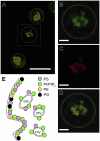Cytoplasmic remodeling of erythrocyte raft lipids during infection by the human malaria parasite Plasmodium falciparum
- PMID: 17526861
- PMCID: PMC1976375
- DOI: 10.1182/blood-2007-04-083873
Cytoplasmic remodeling of erythrocyte raft lipids during infection by the human malaria parasite Plasmodium falciparum
Abstract
Studies of detergent-resistant membrane (DRM) rafts in mature erythrocytes have facilitated identification of proteins that regulate formation of endovacuolar structures such as the parasitophorous vacuolar membrane (PVM) induced by the malaria parasite Plasmodium falciparum. However, analyses of raft lipids have remained elusive because detergents interfere with lipid detection. Here, we use primaquine to perturb the erythrocyte membrane and induce detergent-free buoyant vesicles, which are enriched in cholesterol and major raft proteins flotillin and stomatin and contain low levels of cytoskeleton, all characteristics of raft microdomains. Lipid mass spectrometry revealed that phosphatidylethanolamine and phosphatidylglycerol are depleted in endovesicles while phosphoinositides are highly enriched, suggesting raft-based endovesiculation can be achieved by simple (non-receptor-mediated) mechanical perturbation of the erythrocyte plasma membrane and results in sorting of inner leaflet phospholipids. Live-cell imaging of lipid-specific protein probes showed that phosphatidylinositol (4,5) bisphosphate (PIP(2)) is highly concentrated in primaquine-induced vesicles, confirming that it is an erythrocyte raft lipid. However, the malarial PVM lacks PIP(2), although another raft lipid, phosphatidylserine, is readily detected. Thus, different remodeling/sorting of cytoplasmic raft phospholipids may occur in distinct endovacuoles. Importantly, erythrocyte raft lipids recruited to the invasion junction by mechanical stimulation may be remodeled by the malaria parasite to establish blood-stage infection.
Figures





References
-
- Dvorak JA, Miller LH, Whitehouse WC, Shiroishi T. Invasion of erythrocytes by malaria merozoites. Science. 1975;187:748–750. - PubMed
-
- Holder AA, Blackman MJ, Borre M, et al. Malaria parasites and erythrocyte invasion. Biochem Soc Trans. 1994;22:291–295. - PubMed
-
- Miller LH, Baruch DI, Marsh K, Doumbo OK. The pathogenic basis of malaria. Nature. 2002;415:673–679. - PubMed
-
- Murphy SC, Samuel BU, Harrison T, et al. Erythrocyte detergent-resistant membrane proteins: their characterization and selective uptake during malarial infection. Blood. 2004;103:1920–1928. - PubMed
-
- Samuel BU, Mohandas N, Harrison T, et al. The role of cholesterol and glycosylphosphatidylinositol-anchored proteins of erythrocyte rafts in regulating raft protein content and malarial infection. J Biol Chem. 2001;276:29319–29329. - PubMed
Publication types
MeSH terms
Substances
Grants and funding
LinkOut - more resources
Full Text Sources
Medical

